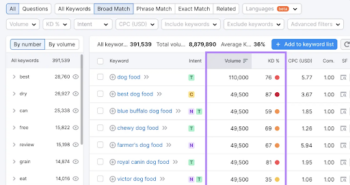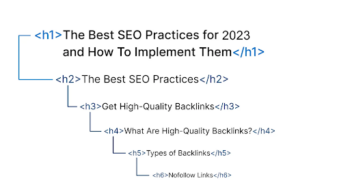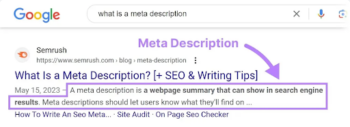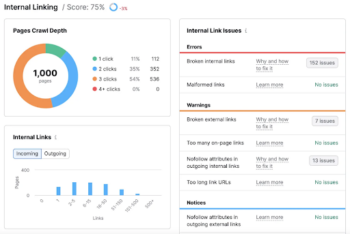ON THE GO? LISTEN TO THE BLOG BELOW.
We’re here to provide you with an in-depth guide on how to write SEO friendly blog posts that earn a top spot in Google’s search results.
If you’ve been searching for advice on how to write SEO friendly blog posts, you’ve probably come across pages and pages of tips and tricks of what you should and shouldn’t do. But to really understand the best practices, we should first take a look at what it really means to write an SEO friendly blog post.
SEO (Search Engine Optimization) plays a crucial role in blogging by enhancing the visibility and traffic of your blog posts. When you optimize your blog content for search engines, it becomes more likely to appear higher in search engine results pages (SERPs), making it easier for users to find and engage with your content.
We’re here today to guide you through the steps on how to write SEO friendly blog posts, ensuring that your blog posts are optimized to rank well in search engines and attract more organic traffic. Let’s get started!
Keyword Research: The Foundation of SEO
Keyword research is vital for SEO. It helps you understand what people are searching for related to your business. By using popular and relevant keywords in your content, you can attract the right audience and improve your website’s visibility. It’s like laying the groundwork for a successful online presence.
Keyword Research: A Step-By-Step Guide
Understand Your Business Goals: Start by identifying the main topics or themes relevant to your business. Consider what products, services, or topics you want to rank for in search engines.
Brainstorm Seed Keywords: Generate a list of seed keywords or phrases that relate to your business. These are broad terms that capture the essence of what you offer.
Expand Your Keyword List: Use a keyword research tool like Semrush to expand your list of keywords. Semrush provides insights into search volume, competition, and related keywords. You then can evaluate the metrics associated with each keyword, such as search volume, competition level, and keyword difficulty.
Higher search volume keywords offer greater potential traffic, but they often come with increased competition. If you’re just getting started, it’s sometimes more beneficial to prioritize high rankings for low-volume keywords, as they can yield better click-through rates.
But, as your site’s SEO improves, you can gradually scale up to target more competitive keywords, maximizing your online visibility and organic traffic over time.
Consider User Intent: Think about the intent behind each keyword. Are users looking for information, products, or services? Tailor your keyword selection to match user intent. For example, searching for “how to write SEO friendly blog posts” is a great example of user intent that allows you to start writing content to answer that search query.
Implement Keywords Strategically: Once you’ve selected your target keywords, incorporate them naturally into your website content, including page titles, headings, meta descriptions, and body copy. Here’s a few tips on how to do that:
- Keyword Placement: Integrate keywords naturally into your content, including in the title (here are some tips for making that title catchy and click-worthy!), headings, and throughout the body text. Aim for a conversational tone, ensuring that the keywords fit seamlessly into the context of the content.
- Semantic Variations: Use variations of your target keywords and related terms to provide context and depth to your content. This not only helps with SEO but also improves the overall quality and relevance of your content for readers.
- User Intent Focus: Prioritize addressing the user’s search intent when incorporating keywords. Understand what users are looking for when they search for a specific keyword and create content that meets their needs effectively. This approach not only enhances SEO but also boosts user engagement and satisfaction.
Monitor and Adjust: Regularly monitor the performance of your chosen keywords using analytics tools. Adjust your keyword strategy as needed based on changes in search trends and user behavior.
Crafting an SEO-Friendly Blog Structure
When it comes to writing a blog post that performs well in search engine rankings, having a clear and logical structure is paramount. Not only does it enhance readability for your audience, but it also signals to search engines the relevance and hierarchy of your content. Here are some key considerations for crafting an SEO-friendly blog structure:
Clear Organization
Make sure your blog post is easy to read and understand. Break your content into sections and subsections to help readers navigate and grasp your main points.
Use Headings Effectively
Use headings (like H1, H2, H3) to structure your content. The main title of your post should be an H1, with subheadings as H2 and H3. Use descriptive headings that include keywords related to your topic.
Optimize Your Meta Tags for Maximum Impact
Meta titles and descriptions are essential components of SEO, serving as quick summaries of web page content displayed in search engine results. They play a crucial role in attracting clicks and informing users about the relevance of your page.
Creating well informed, but short, meta titles and descriptions with relevant keywords can improve your search visibility and click-through rates, ultimately enhancing your overall SEO performance.
Include Internal Links
Linking to internal content is crucial for enhancing the user experience and improving SEO. Linking to relevant internal pages within your website helps users navigate your site more easily, encourages exploration of related topics, and distributes link equity throughout your site. It also helps search engines crawl and index your site more effectively, improving overall visibility.
Utilizing tools like Semrush’s Site Audit tool can further optimize your internal linking strategy by identifying and addressing common issues, including:
- High crawl depth: Pages that require multiple clicks to access, which can hinder user experience and indexing efficiency.
- Broken links: Addressing broken internal links ensures a seamless browsing experience and prevents potential SEO issues.
- Nofollow attributes: Checking for and adjusting nofollow attributes on internal links can ensure that authority flows effectively throughout your site.
- Non-descriptive anchor text: Using descriptive anchor text improves user understanding and search engine relevance, optimizing the impact of internal links.
What’s Left?
We know how to write SEO friendly blog posts, and we’re here to help you do the same! By incorporating these strategies into your writing process, you can boost your blog’s visibility and attract more readers. If you’re not sure where to start or need assistance, our team is here to help. Reach out to us today, and let’s work together to make your blog stand out in the digital world!












